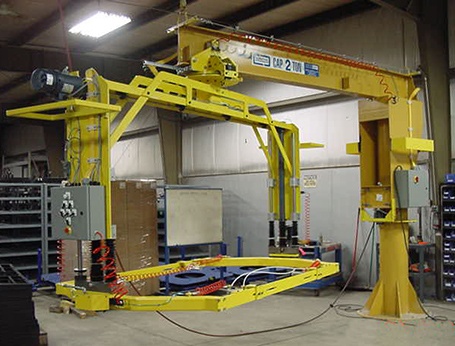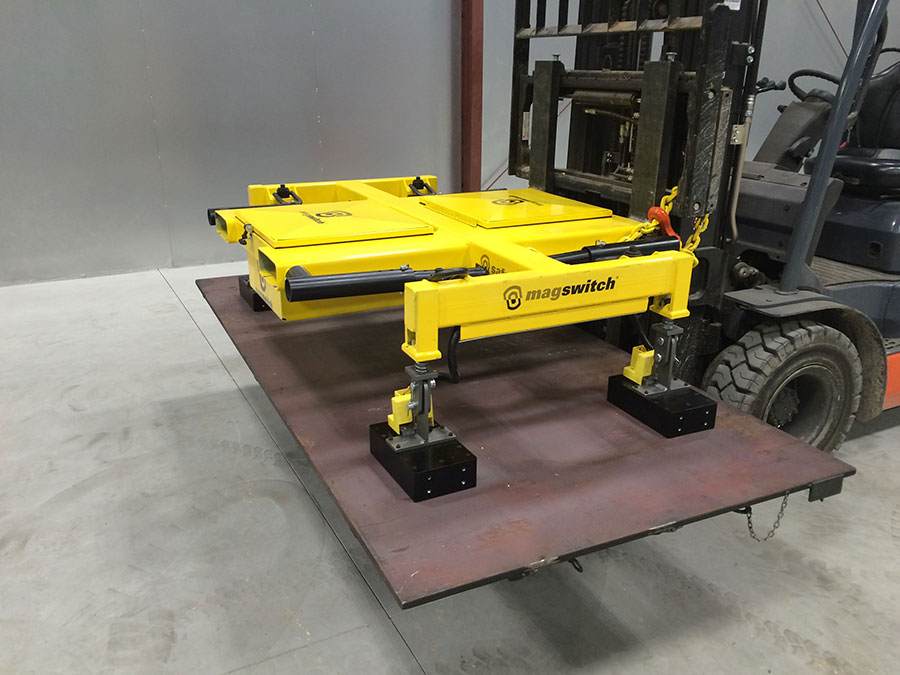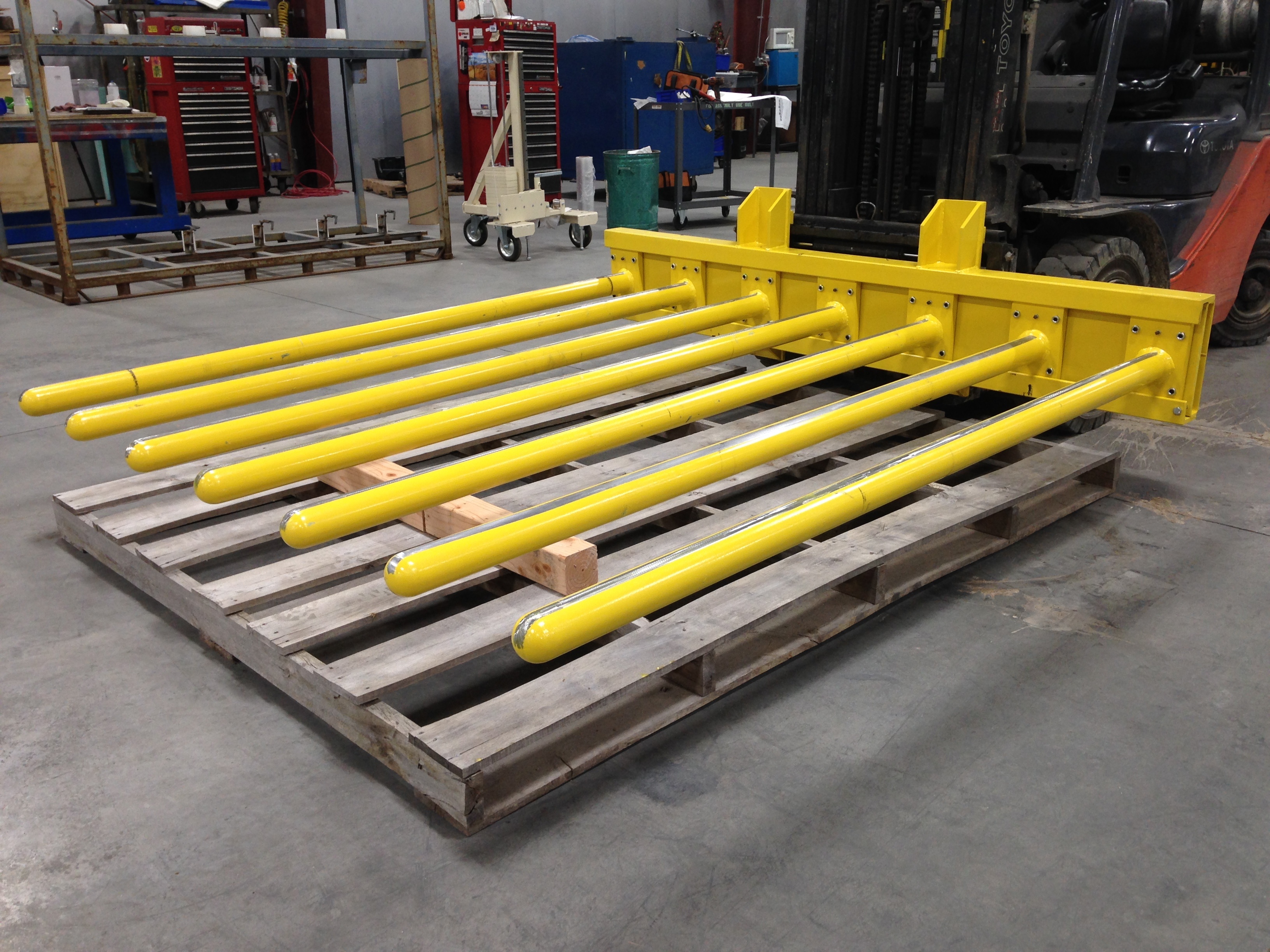
Plymouth Industries, Inc. has lifted everything from truck cabs, foundry cores, paper cores, plate steel, engines, shocks, dies, and much more. We have core lift assist device competencies in magnetic, mechanical, pneumatic, and hydraulic lifting technology.
Our custom lifting device design, fabrication, and testing process follows the strictest safety standards in the lifting industry.
- Computerized or manual
- Certified in-house by professional engineer
- 3D modeled
- Stress analysis
- Load tested, proof tested by trained professionals
Request a Quote
Plymouth Industries, Inc. stands behind our products and guarantees all workmanship. We only use high-grade materials and components, and believe a partnership with you will achieve more effective and efficient solutions. We look forward to the opportunity to work together soon.
Lifting devices play a crucial role in the efficient and safe handling of materials across various industries. Whether it’s heavy machinery, components, or goods, lifting fixtures provide a reliable means of lifting, positioning, and transporting loads. In this article, we will explore the different types of lifting fixtures, their benefits, factors to consider when choosing one, best practices for their use, and maintenance guidelines. We will also discuss the significance of lifting fixtures in different industries and touch upon the future trends in this field.
What are Lifting Devices?
Lifting devices, also known as lifting fixtures or lifting equipment, are mechanical devices designed to facilitate the lifting, lowering, and movement of loads. These fixtures are specifically engineered to ensure secure and stable lifting operations, preventing accidents and damage to both the load and the equipment.
Types of Lifting Devices
- Magnetic Lifters: These fixtures employ powerful magnets to lift ferrous materials, such as steel plates or pipes. They find applications in metal fabrication and scrap handling.
- Forklift Attachments: These fixtures attached to a forklift to expand its functionality and enhance its lifting capabilities. These attachments are designed to handle specific types of loads or perform specialized tasks, allowing the forklift to adapt to different material handling requirements.
- Hydraulic Lift Tables: These fixtures utilize hydraulic cylinders to lift and lower loads. They are commonly used in warehouses, manufacturing facilities, and distribution centers.
- Jib Cranes: Jib cranes have a horizontal arm (jib) that can rotate to lift and transport loads within a limited area. They are commonly found in workshops and small-scale manufacturing units.
Types of Forklift Attachments
- Fork Extensions: Fork extensions are metal extensions that attach to the existing forks of a forklift, effectively increasing their length. They enable the forklift to handle longer loads that exceed the standard fork length.
- Side Shifters: Side shifters are attachments that allow the forklift operator to move the forks horizontally, either to the left or right, without repositioning the entire forklift. This feature improves load placement accuracy and maneuverability.
- Rotators: Rotators are attachments that enable the forklift to rotate the load while it is still lifted. This is particularly useful for applications that require material rotation, such as dumping or emptying containers.
- Clamps: Forklift clamp attachments are designed to securely grip and handle loads that cannot be lifted with forks alone. They are commonly used for handling items like drums, barrels, or paper rolls.
- Bale Clamps: Bale clamps are specialized attachments used for handling bales of materials, such as hay, cotton, or recycled materials. They provide a secure grip around the bale, allowing for efficient lifting and stacking.
- Carton Clamps: Carton clamps are attachments specifically designed for handling cartons or boxes. They have padded surfaces to grip the load without damaging it, making them ideal for warehouse or distribution center applications.
- Push/Pull Attachments: Push/pull attachments allow the forklift to push or pull loads without the need for manual handling or additional equipment. These attachments are commonly used in industries such as paper and textile handling.
- Fork Positioners: Fork positioners are attachments that enable the forklift operator to adjust the distance between the forks, allowing for easy handling of loads with varying widths. They eliminate the need for manual fork adjustment, improving efficiency.
Benefits of Lift Assist Devices
- Improved Efficiency: Lifting fixtures streamline material handling processes, reducing manual effort and time required to lift and move heavy loads.
- Enhanced Safety: By providing stable lifting and secure load attachment, lifting fixtures minimize the risk of accidents, injuries, and damage to goods.
- Versatility: Different types of lifting fixtures cater to various load sizes, weights, and shapes, making them adaptable for diverse industries and applications.
- Ergonomics: Lifting fixtures promote better ergonomics by reducing strain on workers’ bodies, minimizing the risk of musculoskeletal disorders.
Factors to Consider When Choosing Lifting Devices
- Load Capacity: Ensure that the lifting fixture can handle the maximum weight of the loads you intend to lift.
- Size and Dimensions: Consider the size and shape of the loads to ensure compatibility with the fixture’s design.
- Environment: Assess the working environment, including factors like temperature, humidity, and the presence of dust or corrosive substances, to choose a lifting fixture that can withstand those conditions.
- Safety Features: Look for lifting fixtures with built-in safety features such as limit switches, overload protection systems, and emergency stop buttons.
- Compliance with Standards: Ensure that the lifting fixture meets relevant safety and quality standards set by regulatory bodies.
Best Practices for Using Lifting Fixtures
- Conduct Proper Training: Train operators on the correct usage, safety protocols, and maintenance of the specific lifting fixtures they will be operating.
- Inspect Before Use: Thoroughly inspect the lifting fixture before each use to identify any signs of damage or wear that may affect its functionality or safety.
- Secure the Load: Ensure that the load is properly secured to the lifting fixture using appropriate attachments, such as slings, chains, or hooks.
- Consider Weight Distribution: Distribute the load evenly on the lifting fixture to maintain stability and prevent tipping or imbalance.
- Clear Communication: Establish clear communication protocols between the operator and other workers involved in the lifting operation to prevent accidents.
- Regular Maintenance: Follow the manufacturer’s recommended maintenance schedule to keep the lifting fixtures in optimal condition and address any potential issues promptly.
Maintenance and Safety Guidelines
- Regular Inspections: Schedule routine inspections to identify any wear, damage, or malfunctioning components. Replace or repair as necessary.
- Lubrication: Apply appropriate lubricants to moving parts to reduce friction and ensure smooth operation.
- Load Capacity Awareness: Avoid exceeding the lifting fixture’s specified load capacity to prevent equipment failure or accidents.
- Safety Devices: Check and test safety devices, such as limit switches or overload protection systems, to ensure they are functioning correctly.
- Operator Awareness: Train operators to be vigilant and report any abnormalities, unusual noises, or malfunctions during operation promptly.
- Record-Keeping: Maintain detailed records of inspections, maintenance activities, and repairs performed on the lifting fixtures.
Lifting Fixtures in Different Industries
- Manufacturing: Lifting fixtures are crucial for lifting heavy machinery parts, molds, and equipment during production processes.
- Construction: Construction sites rely on lifting fixtures such as cranes and hoists to lift and transport materials, scaffolding, and heavy structural components.
- Warehousing and Logistics: Lifting fixtures are integral to efficiently load and unload goods from trucks, stack pallets, and organize inventory.
- Automotive: Lifting fixtures are used in automobile assembly lines to raise vehicles for inspections, repairs, and component installations.
- Aerospace: Lifting fixtures play a vital role in the assembly, maintenance, and transport of aircraft components.
Future Trends in Lifting Fixtures
- Automation: The integration of automation and robotics in lifting fixtures enables more precise and efficient material handling.
- IoT Connectivity: Lifting fixtures with IoT capabilities allow for real-time monitoring, predictive maintenance, and data-driven optimization of lifting operations.
- Safety Innovations: Continued advancements in safety features, such as advanced sensors and collision detection systems, further enhance the safety of lifting fixtures.
- Lightweight and Portable Designs: The development of lighter and more portable lifting fixtures makes them easier to transport and deploy in different work environments.
- Sustainability: Lifting fixtures that focus on energy efficiency and eco-friendly materials contribute to sustainable practices in material handling operations.
FAQs (Frequently Asked Questions)
1. Are lifting fixtures suitable for all types of loads?
Lifting fixtures come in various types and configurations to accommodate different loads. It’s essential to choose the right fixture based on the load’s weight, size, and shape.
2. Can lifting fixtures be customized for specific requirements?
Yes, lifting fixtures can be customized to meet specific requirements. Manufacturers often offer customization options to ensure the fixture aligns with the unique needs of the industry or application.
3. Are there any weight limits for lifting fixtures?
Yes, lifting fixtures have weight limits specified by the manufacturer. Exceeding the weight limit can compromise the safety and functionality of the fixture, so it’s crucial to adhere to the specified capacity.
4. How often should lifting fixtures undergo maintenance?
Lifting fixtures should undergo regular maintenance as per the manufacturer’s guidelines. This typically includes routine inspections, lubrication, and addressing any identified issues promptly.
5. What are the common safety features in lifting fixtures?
Common safety features in lifting fixtures include limit switches, overload protection systems, emergency stop buttons, and collision detection sensors. These features ensure safe operation and protect against accidents.



